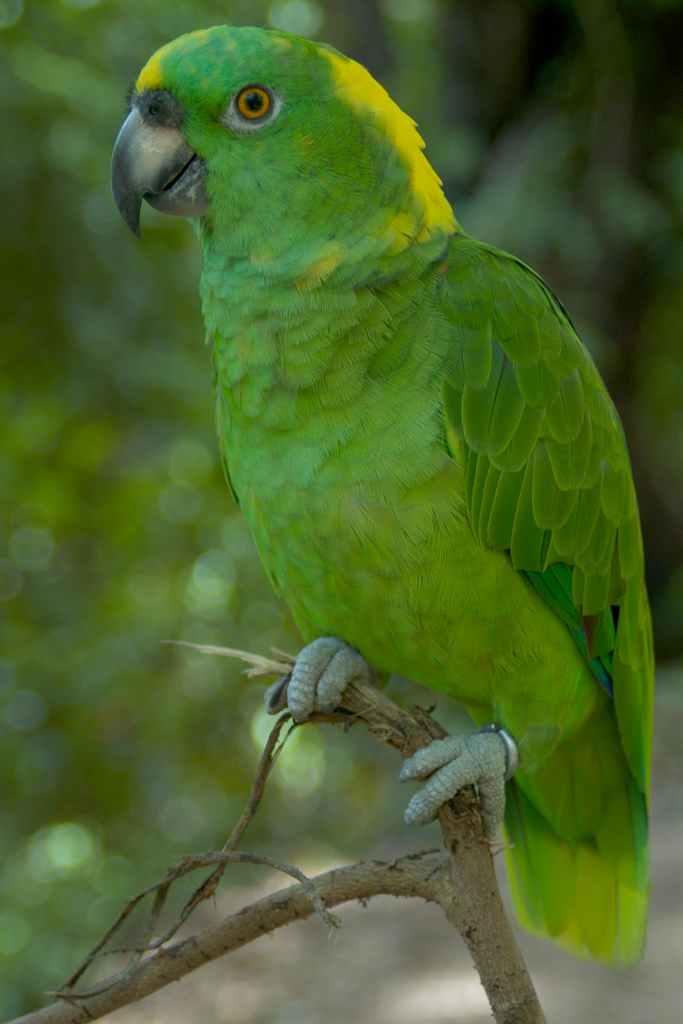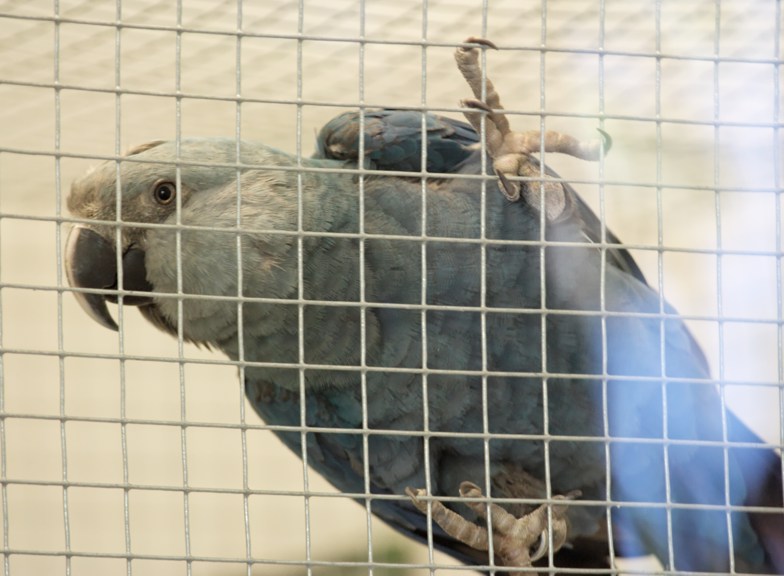 Many countries have placed an outright ban on capturing wild parrots (Mexico, most recently) and, as in the USA, require proof that birds offered for sale have been bred in captivity. Abuses occur, but rarely on the scale exhibited recently in the central African nation of the Democratic Republic of Congo (DRC). Major conservation groups are outraged at the behavior of the DRC government, which seems to be in collaboration with parrot smugglers. Read More »
Many countries have placed an outright ban on capturing wild parrots (Mexico, most recently) and, as in the USA, require proof that birds offered for sale have been bred in captivity. Abuses occur, but rarely on the scale exhibited recently in the central African nation of the Democratic Republic of Congo (DRC). Major conservation groups are outraged at the behavior of the DRC government, which seems to be in collaboration with parrot smugglers. Read More »
Tag Archives: Bird Conservation
Feed SubscriptionBald Parrot Among New Species Discovered in the Amazon Basin
Animals unknown to science, including sizable mammals, come to light every day (in fact, 1 every 3 days for the past decade in the Amazon Basin alone!). But parrots, being loud, colorful and active by day, have a hard time remaining undetected, even in remote habitats. Brazil’s Bald or Orange-Headed Parrot (Pyrilia aurantiocephala), however, despite being glimpsed in the past, was only recognized as a distinct species in 2002.
Incredible Species Diversity
The World Wildlife Fund recently announced that over 1,200 new species have been discovered since 1999 in the area of South America drained by the Amazon River, popularly known as the Amazon Basin. The region is a hotbed of diversity (new insects are so numerous that they were excluded from the report, and more fish species have been found in the Amazon than in the entire Atlantic Ocean!), but birds accounted for only 16 of the new discoveries. However, among these was a real shocker – a noisy blue and aquamarine parrot with a featherless, orange head. Read More »
Conservation Update – Mexico Bans the Capture and Export of Wild Parrots
 Parrot conservation took an important step forward this month (October, 2010) as Mexico’s president signed into law a bill prohibiting the capture and export of wild parrots of any species.
Parrot conservation took an important step forward this month (October, 2010) as Mexico’s president signed into law a bill prohibiting the capture and export of wild parrots of any species.
The Parrot Trade in Mexico
The president’s action was sparked in a large part by the results of a long-term study (please see below) of Mexico’s parrots and the effect of the trade on their continued existence. The study, undertaken by groups based in Mexico and the USA (Teyeliz, A.C. and Defenders of Wildlife) provided dramatic evidence that the collection of wild parrots directly contributes to the decline of many species, and will likely lead some to extinction. Some of the facts to emerge were shocking – for example, of the 78,000 parrots believed taken from the wild in Mexico annually, 50-60,000 perish before reaching a buyer! Read More »
Planning for the Spix Macaw’s Return to the Wild
 My experience with reintroduction programs for creatures ranging from spiders to Guam Kingfishers has convinced me that the good intentions of conservationists, standing alone, are never sufficient to ensure any creature’s long-term survival. Conservation must make economic sense to people living in the habitat where the work is being done, and they must also genuinely favor the animal’s return. Today I’d like to highlight a program that is doing an excellent job at laying the groundwork for the return of the Spix Macaw (Cyanopsitta spixii) to Brazil.
My experience with reintroduction programs for creatures ranging from spiders to Guam Kingfishers has convinced me that the good intentions of conservationists, standing alone, are never sufficient to ensure any creature’s long-term survival. Conservation must make economic sense to people living in the habitat where the work is being done, and they must also genuinely favor the animal’s return. Today I’d like to highlight a program that is doing an excellent job at laying the groundwork for the return of the Spix Macaw (Cyanopsitta spixii) to Brazil.
Gone but not Forgotten
Extinct in the wild since 2000 and represented by less than 100 captive individuals, the beautiful blue Spix Macaw is among the rarest of all birds.
Recently, representatives of the group Parrots International visited Curaca, Brazil (Bahia State), the former habitat of this bird, in order to access reintroduction possibilities. A Loro Paraque Foundation project that had been in place in Curaca had been cancelled 4 years prior, but the area’s tiny schoolhouse retained the name given it by local children at that time – The Spix Macaw School.
Children’s Concern Sparks Groups to Donate
Children in the area remained concerned about birds – fearing the researcher’s truck held bird-poachers, 3 youngsters stalked it for several miles in the broiling sun, and spied on its occupants! Moved by the concern evidence by this action, Parrots International supplied the school with the funds it needed to remain in operation (located in one of Brazil’s poorest sectors, it was about to be closed).
Other groups joined the effort, and soon the school was provided with nighttime electricity (to allow for much-needed adult classes), an upgraded toilet and supplies. In order to assist adults in attending evening reading and writing classes, meals are also supplied.
In addition, 4,000 acres of prime Spix Macaw habitat, known as the Gangorra Farm, has been purchased by Parrots International and the Lymington Foundation.
Practical Conservation
This program presents a fine example of an effective strategy – public support for the macaws was obviously strong, but the practicalities of life in a poor, rural area would likely have prevented effective action. By attending to some basic needs of both adults and children, and placing important habitat under private ownership, Parrots International and its partners have set the stage for what may someday be a successful reintroduction program for the magnificent Spix Macaw.
Further Reading
Learn how to help this and other species via donations, purchases or volunteer action here.
Video of Spix Macaw breeding program.
Spixara image referenced from wikipedia and originally posted by Robert01
The Sisserou or Imperial Amazon – Largest, Most Colorful and Rarest Amazon
 Amazons are among the most popularly-kept and parrots, yet among their ranks we find some very rare and little-studied species. Interestingly, the largest and most spectacularly colored of the Amazons is hardly known at all to parrot enthusiasts. I think it’s important to highlight the rare members of well-known bird groups, as anything we learn concerning the habits and needs of common species may be of use in helping their less-fortunate relatives. Today I’d like to introduce the Sisserou, also known as the Imperial or Dominican Amazon (Amazona imperialis).
Amazons are among the most popularly-kept and parrots, yet among their ranks we find some very rare and little-studied species. Interestingly, the largest and most spectacularly colored of the Amazons is hardly known at all to parrot enthusiasts. I think it’s important to highlight the rare members of well-known bird groups, as anything we learn concerning the habits and needs of common species may be of use in helping their less-fortunate relatives. Today I’d like to introduce the Sisserou, also known as the Imperial or Dominican Amazon (Amazona imperialis).
Description
Clad in bright blue, green, purple and red, the Sisserou is considered by many to be the most spectacularly-colored of the Amazon Parrots. The effect of its gorgeous plumage is heightened by the bird’s size – at 18 inches in length and with a wingspan approaching 3 feet, it is the largest Amazon. Read More »
 That Bird Blog – Bird Care and History for Pet Birds
That Bird Blog – Bird Care and History for Pet Birds
